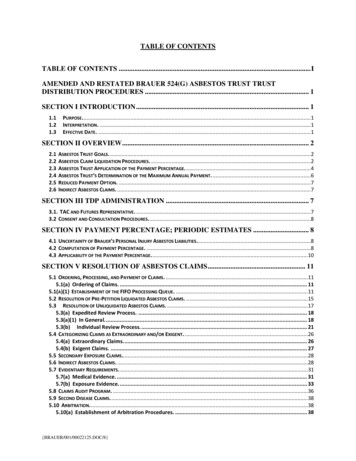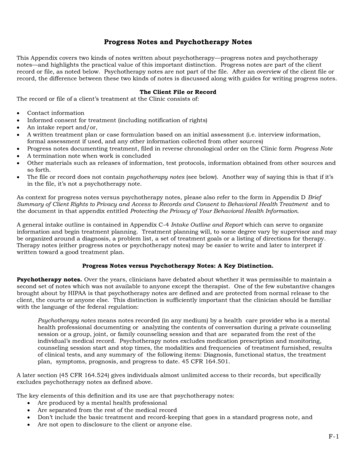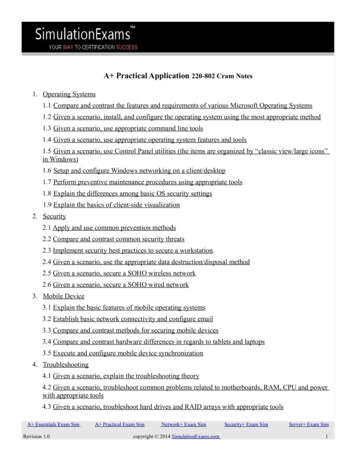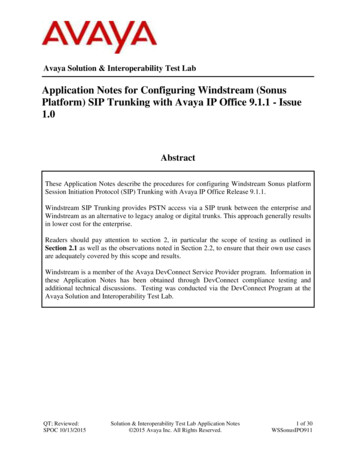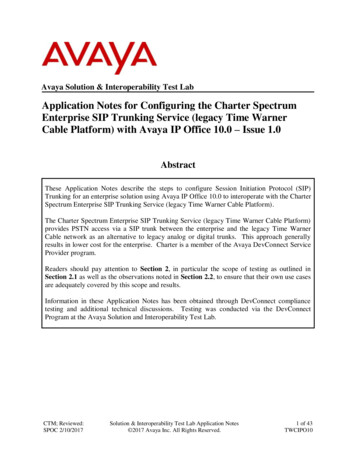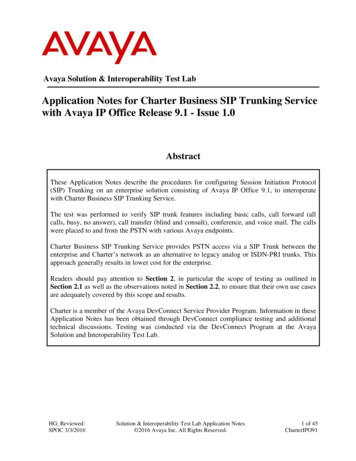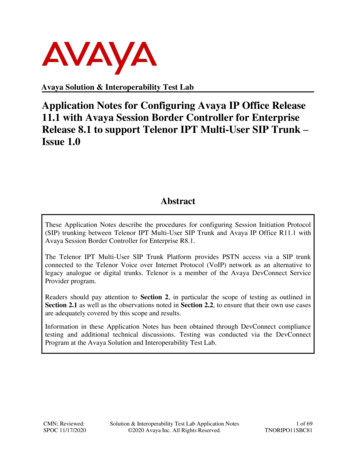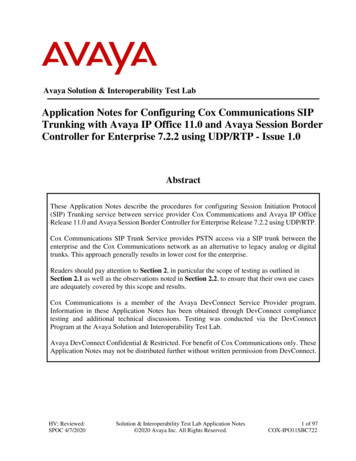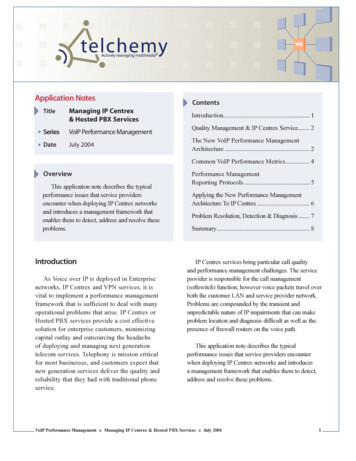
Transcription
Application NotesContentsManaging IP Centrex& Hosted PBX ServicesSeriesVoIP Performance ManagementDateJuly 2004TitleIntroduction. 1Quality Management & IP Centrex Service. 2The New VoIP Performance ManagementArchitecture. 2Common VoIP Performance Metrics. 4OverviewThis application note describes the typicalperformance issues that service providersencounter when deploying IP Centrex networksand introduces a management framework thatenables them to detect, address and resolve theseproblems.IntroductionAs Voice over IP is deployed in Enterprisenetworks, IP Centrex and VPN services, it isvital to implement a performance managementframework that is sufficient to deal with manyoperational problems that arise. IP Centrex orHosted PBX services provide a cost effectivesolution for enterprise customers, minimizingcapital outlay and outsourcing the headacheof deploying and managing next generationtelecom services. Telephony is mission criticalfor most businesses, and customers expect thatnew generation services deliver the quality andreliability that they had with traditional phoneservice.VoIP Performance ManagementPerformance ManagementReporting Protocols. 5Applying the New Performance ManagementArchitecture To IP Centrex. 6Problem Resolution, Detection & Diagnosis. 7Summary. 8IP Centrex services bring particular call qualityand performance management challenges. The serviceprovider is responsible for the call management(softswitch) function; however voice packets travel overboth the customer LAN and service provider network.Problems are compounded by the transient andunpredictable nature of IP impairments that can makeproblem location and diagnosis difficult as well as thepresence of firewall routers on the voice path.This application note describes the typicalperformance issues that service providers encounterwhen deploying IP Centrex networks and introducesa management framework that enables them to detect,address and resolve these problems.Managing IP Centrex & Hosted PBX ServicesJuly 20041
TelchemyQuality Management & IP Centrex ServiceFor example, SNMP requests fromthe service provider to devices on thecustomer LAN can be blocked by thecustomer’s firewall router.Customers expect that their IP Centrex or HostedPBX service provider will manage the quality ofthe service they provide, thus requiring that theservice provider monitor and manage call quality andtroubleshoot any related problems. In today’s market,customers often request a SLA to hold the serviceprovider accountable for overall service and call quality.Service level is specified at an interface ordemarcation point on the network. For IP Centrex andmanaged IP services, this is usually the edge routerlocated in the customer premises. Hence, the serviceprovider is responsible for problems in the core networkand on the access link, and the customer is technicallyresponsible for problems on their LAN.In an IP Centrex service, voice packets travelbetween an IP phone on a user desktop through a LAN,access link and core IP network to a trunking gatewaywhich results in several problems:Since different network segments are“owned” by different entities i.e., theservice provider and the customer, theymay not know what effect their specificnetwork segment is having on the IPphone call. In addition, the serviceprovider may not have managementaccess into their customer’s LAN inorder to retrieve diagnostic informationfrom IP phones or gateways.Network problems are transient in natureand can occur at many places along thepacket path. By the time a user reports aproblem, the network condition causingthat problem may have disappeared.Service providers can’t use existingmanagement protocols such as SNMP dueto both bandwidth and security issues.2Application NotesSome problems e.g., echo, result from theinteraction of the two endpoints (trunkinggateway and IP phone) and the network.Measuring echo and loss plan can becostly and impractical when Secure RTPis deployed and voice packet payloads areencrypted.Due to these problems, IP Centrex service providersneed a performance management architecture thatsupports contractual SLA monitoring at the servicedemarcation point, diagnostic service level monitoringat the IP phone and trunking gateway and fast, easyproblem diagnosis.The New VoIP PerformanceManagement ArchitectureA new standards-based framework has emergedwithin the IP industry for VoIP PerformanceManagement. It uses a distributed software probearchitecture to provide cost-effective, real-timecall quality feedback with maximum networkcoverage. The new framework’s monitoringfunctions provide real-time visibility of networkperformance, detection of transient problems andcomprehensive diagnostic data.It also provides QoS reporting protocols with theability to send data back to network management andcall control systems with minimal network trafficoverhead. The architecture features high performancenetwork probes located within the core network andat major customer locations that provide in-depthdiagnosis when they detect problems.VoIP Performance ManagementManaging IP Centrex & Hosted PBX ServicesJuly 2004
TelchemyApplication NotesA key benefit of the new VoIP PerformanceManagement Architecture is that small lightweightmonitoring functions can be integrated directly intoIP phones, routers, gateways and similar networkelements. This “direct integration” provides probefunctionality in equipment where it would normally becost prohibitive e.g., every customer desktop.Embedded Monitoring FunctionVQmon technology is a major building blockof the new performance framework; it was thefirst and is the most widely deployed monitoringfunction for VoIP performance management today.VQmon’s embedded monitoring technologyenables network managers to see call qualityproblems in real-time and identify the root causeof the problem for both active and completed calls.VQmon measures key characteristics ofthe packet stream and calculates real-timeperformance data that network managers canuse to detect, characterize and report transientproblems. The technology provides detailedinformation on service quality with less reportingfrequency, thus requiring less bandwidth.VQmon is a high performance standards-basednon-intrusive call quality monitoring and diagnosticagent that can be integrated directly into VoIP CPE,SLA monitoring systems, probes, routers and generallyany system that is on the path taken by voice packets(Figure 1). VQmon agents are small and highly efficientand can be integrated into existing equipment withoutrequiring additional CPU or memory, scaling fromsystems that monitor a single call to those that support“hundreds of thousands” of calls.VQmon agents produce call quality metrics,including listening and conversational quality scores.They also provide detailed information on the severityand distribution of packet loss and discards due to jitterand other essential diagnostic data. Most importantly,VQmon is able to detect transient IP problems andassess their effects on call quality.VQmon supports key international standards includingITU-T P.564, ITU-T G.107, ITU-T G.1020, ETSI TS 101329-5 Annex E and IETF RFC 3611. VQmon incorporatessupport for time varying IP impairments (typically causedby network congestion) and has been independently shownto provide significantly more accurate and stable metricsthan other algorithms such as G.107 (E Model).Call Server andCDR DatabaseSignaling-basedQoS ReportingVoIPEndpointNetworkManagementSystemSNMP withRTCP XR MIBRTCP XR (RFC3611)Media Path ReportingVoIP GatewayEmbedded monitoringwith VQmon Network Probeor AnalyzerVoIP Performance ManagementManaging IP Centrex & Hosted PBX ServicesG.799.1Trunking GatewayJuly 2004Figure 1: The newVoIP PerformanceManagementReference Model3
TelchemyThere are two versions of VQmon: VQmon/EP(End Point) and VQmon/SA (Stream Analysis). Bothproduce a rich set of diagnostic data and support thecommon VoIP performance management metrics.IP Phones and Gateway Monitoring: VQmon/EPLeading equipment manufacturers are integratingVQmon/EP into their IP phones and gateways. VQmon/EP monitors the received packet stream and extractsother vital information from the VoIP CODEC. VQmoncan use this information to provide accurate call qualityestimates and supporting diagnostic data.Common VoIP Performance MetricsThe new VoIP Performance Management Architectureincorporates a common set of VoIP performance metricssupported by multiple QoS reporting protocols i.e., thesame information is available regardless of the protocolused for reporting (Figure 2). These metrics are:Percentage Of Packets Lost By theNetworkPercentage Of Packets Discarded By theJitter Buffer Due To Late ArrivalSLA Monitors, Analyzers and Probes: VQmon/SABoth these metrics help to identify the degreeto which a call is being affected by networkpacket loss or jitter. They also eliminate theneed to “guess” how much effect jitter ishaving on packet discard rate.VQmon/SA is the core VoIP analysis software used inmany probes, routers, SLA monitoring systems and analyzers.VQmon/SA monitors the packet stream, automaticallyrecognizing individual call streams and the types of CODECin use. VQmon determines which packets were lost or wouldbe discarded due to jitter and uses this data to determine a callquality estimate using the same algorithms as VQmon/EP.SLA MonitorProtocol AnalyzerRouterApplication NotesMean Length and Density Of Bursts(where a burst is defined as an interval oftime during which the packet loss/discardrate is high enough to cause audio qualitydegradation)IP PhoneVoIP GatewayIP NetworkCODECVQmonVQmonVQmon/SA“Stream Analysis”4RTCP XRVQmon/EP“End Point”VoIP Performance ManagementFigure 2: VQmon'sembedded monitoringtechnologyManaging IP Centrex & Hosted PBX ServicesJuly 2004
TelchemyApplication NotesMean Length and Density Of GapsBetween BurstsJitter Buffer Configuration and PacketLoss Concealment AlgorithmBoth these metrics help to identify the extentto which a call is degraded by loss/discard andprovide some insight into the user experience.Transient network congestion is a commonproblem resulting in a period of high loss/discard lasting for several seconds duringwhich call quality is degraded; these transientcall quality problems are reported as “bursts.”This information is used to determine ifpoor call quality is due to an incorrectlyconfigured end system and to allow midstream probes to automatically detectendpoint configuration.Round Trip Delay Between VoIP EndpointsEnd System Delay Within a VoIP EndpointBoth these metrics help to identify thesources of excessive delay which can leadto conversational difficulty and greatlyintensify the effects of echo.Signal LevelNoise LevelPerformance ManagementReporting ProtocolsReporting protocols have been developed for themedia path, signaling system and network management.It is important to realize that these are complementaryi.e., they are designed to be used together.RTCP Reporting Extensions (RTCP XR)The RTCP XR protocol (RFC3611) is a media pathreporting protocol that exchanges call quality metricsbetween VoIP endpoints. RTCP XR provides severaluseful functions:Echo LevelThese three metrics enable detection ofproblems due to excessive variations in signal,noise or echo level. They also allow midstream probes to detect signal, echo and noiselevel problems without needing to decodevoice packets. These metrics will be essentialwhen networks use the secure RTP framework.Call Quality Metrics In Either R OrMOS ScalingThese metrics provide an immediateview of call quality. If it is apparent thatthere is a problem, the other metrics canbe used for diagnosis.VoIP Performance ManagementManaging IP Centrex & Hosted PBX ServicesEnables collection of call quality reportsby the remote endpoint e.g., a trunkinggateway, or by intermediate probesProvides ability to pass transparentlythrough firewall routersSupports the diagnosis of echo-related problemsEnables network probes to obtain analogsignal information without the need todecode voice packetsCompatibility with the emerging SecureRTP security framework.July 20045
TelchemySignaling Protocol QoS ReportingSeveral new QoS Reporting protocols have beendeveloped within ITU and IETF that support call qualityreporting to call management systems e.g., softswitches.These protocols provide call quality informationdirectly to the systems that maintain CDR databasesand link service quality information directly to specificcustomers and their calls. QoS reporting protocols forH.323 (H.460.9 Annex B) and Megaco (H.248.30) wereapproved in early 2004, and new protocols for SIP andMGCP are expected in mid- to late-2004.Application NotesApplying the New PerformanceManagement Architecture to IP CentrexThe new VoIP performance managementarchitecture is very useful in providing real-timevisibility of user perceived quality in an IP Centrexapplication (Figure 3).VQmon is integrated into the IP phoneon a customer desktop or an integratedaccess device, edge router or multiservice gateway. During an activecall, service quality for the networkto-customer direction of the call ismonitored at the service demarcationpoint and RTCP XR reports areperiodically inserted into the packetstream to provide real-time feedbackto the service provider. In addition, callquality reports may be forwarded throughthe signaling protocol e.g., H.323 or SIP.SNMP and the RTCP XR MIBAn RTCP XR Management Information Base(MIB) is under development within the IETF foruse in gateways or probes to support the retrieval ofmetrics via SNMP. For example, RTCP XR could beused to relay call quality information from an IP phoneto the gateway that forms the network end of a VoIPconnection; and SNMP would be used to retrieve callquality information from the gateway for both in-boundand out-bound packet streams.Central LocationBranch OfficeRTCP XR Reportingbetween EndpointsIP Phones withembeddedmonitoringSQProbeIP VPNSIP RTCPReportingNMS/OSSSIP RTCPReportingIP Phones withembeddedmonitoringTeleworkerWebService APIIP PhoneSQmediatorEmbedded Voice QualityMonitoring with VQmonFigure 3: The New VoIP Performance Management Architecture for IP Centrex Networks6VoIP Performance ManagementManaging IP Centrex & Hosted PBX ServicesJuly 2004
TelchemyApplication NotesVQmon is integrated into the media/trunking gateway or a probe in theservice provider network. During anactive call, service quality for thecustomer-to-network direction of thecall is monitored at the network end ofthe path, and RTCP XR reports fromthe customer premise equipment arecollected and retrieved using SNMP.This provides visibility into bothdirections of the call.Inbound Access Link CongestionThe softswitch collects QoS reports sentvia the signaling protocol.Outbound Access Link CongestionAt the end of a call, a call quality reportmay be sent from the IP endpoint throughthe signaling protocol to the softswitch.This data can be incorporated into the CallDetail Record database.VQmon is integrated into VoIP testequipment (probes and analyzers).When problems are reported anddetailed analysis is needed, NetworkOperations and Field Service personneluse this test equipment to capture andanalyze call streams.Problem Resolution, Detection and DiagnosisThe new VoIP Performance ManagementArchitecture provides the basis for detecting anddiagnosing different types of call quality-relatedproblems:VoIP Performance Management—If the access link (T1, DSL) from the networkto the customer site has insufficient bandwidth,the jitter level will increase. This will typicallycause the IP Phone to discard a high proportionof packets and can increase the size of thejitter buffer size adding more delay. Users candiagnose congestion problems using VQmongenerated call quality reports sent from either anIP Phone or a router/IAD on the customer sitewhich will show a high rate of packet discards.—If the access link (T1, DSL) from the customersite to the network has insufficient bandwidth, thejitter level will increase. This will typically cause thetrunking gateway in the service provider networkto discard a high proportion of packets and canincrease the size of the jitter buffer, adding to delay.Users can diagnose congestion problems usingVQmon-generated call quality reports retrieved fromthe trunking gateway which will show a high rate ofpacket discards.Duplex Mismatch or Bad EthernetSegment on Customer LAN—If the customer’s LAN is not configuredproperly, there may be a high rate of packet lossthat severely impacts call quality. Users candiagnose duplex mismatches or bad Ethernetsegments using VQmon-generated call qualityreports sent from an IP phone on the customersite which will show a high rate of lost packets.Managing IP Centrex & Hosted PBX ServicesJuly 20047
TelchemyEcho in PSTN—If there is a problem on a remote analog loop, theIP phone on a customer site may experience audibleecho. Users can diagnose echo problems usingVQmon-generated call quality reports sent from theIP phone and the trunking gateway which will show ahigh echo level.SummaryThe new VoIP Performance ManagementArchitecture provides an ideal solution for servicequality monitoring and problem diagnosis. Importantcall quality and diagnostic data is obtained real-timefrom key points on the packet stream and routed tonetwork management systems and CDR databases.Network managers can obtain a reasonable level ofproblem diagnosis simply by using data from VoIP callquality reports; however, in-depth problem analysisrequires the use of probes and analyzers that supportthe new Performance Management Framework as wellas the use of VQmon for call quality analysis.Many of the industry’s leading equipmentmanufacturers are already implementing elementsof the new management framework in IP phones,gateways, routers, probes and analyzers.AcronymsCDRIETFIPITUPBXRTP8Call Detail RecordInternet Engineering Task ForceInternet ProtocolInternationalTelecommunications UnionPrivate Branch ExchangeReal Time ProtocolApplication NotesNotesSLASNMPVoIPVPNVQmon/EPVQmon/SAVoIP Performance ManagementService Level AgreementSimple Network ManagementProtocolVoice Over Internet ProtocolVirtual Private NetworkVQmon End PointVQmon Stream AnalysisManaging IP Centrex & Hosted PBX ServicesJuly 2004
ReferencesTelchemy Application Notes[1] IETF RFC3611 RTP Control Protocol ReportingExtensions (RTCP XR), November 2003[2] ITU-T G.799.1 “Functionality and InterfaceSpecifications for GSTN Transport NetworkEquipment for Interconnecting GSTN and IPNetworks”[3] ITU-T H.460.9 Annex B Support for onlineQoS-monitoring reporting within H.323 systems:Extended Performance Metrics[4] ITU-T H.248.30 RTCP Extended PerformanceMetrics Packages[5] IETF SIPPING draft-johnston-rtcp-summary.02.txt[6] ETSI, “Quality of Service (QoS) measurementmethodologies,” ETSI TS 101 329-5 V1.1.1(2000-11), November 2000.[7] ITU-T, “The E-Model, a computational model for usein transmis sion planning,” Recommendation G.107Series Understanding VoIP PerformanceTitleVoice Quality MeasurementTitleImpact of Delay on VoIP ServicesTitleImpact of Echo on VoIP ServicesTitleData and Fax Modem Performance onVoIP ServicesTitleVoice Quality Estimation in Wireless &TDM EnvironmentsAbout Telchemy, IncorporatedTelchemy, Incorporated is the global leader in VoIPand IP Video fault and performance management withits VQmon family of multimedia quality monitoringand analysis software. Telchemy is the world's firstcompany to provide voice quality managementtechnology that considers the effects of time-varyingnetwork impairments and the perceptual effects of timevarying call quality. Founded in 1999, the company hasproducts deployed worldwide and market
For IP Centrex and managed IP services, this is usually the edge router located in the customer premises. Hence, the service provider is responsible for problems in the core network and on the access link, and the customer is technically responsible for problems on

